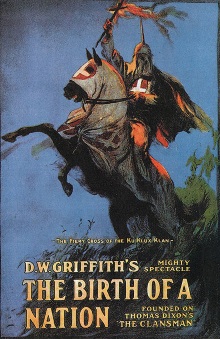
Having watched neither this nor the Nazi documentary Triumph of the Will, I often found myself confusing the two. I guess that some part of me must have internalized that the racist overtones of this film without really being conscious of it. No self-respecting cinephile can get around watching The Birth of a Nation. It’s the first real American feature film, arguably the first film blockbuster anywhere in the world and my cinephile friend recommended it to us as a film that’s actually good for its time, though now that I recall it, he did warn us about how racist it is.
The film is divided into two halves. The first half covers the build-up to the Civil War and the events during the war itself. The second half covers the post-war reconstruction of the southern United States. In both, the main characters are two white families, the Stonemans of the North whose patriarch Austin Stoneman is a powerful politician and a staunch abolitionist of slavery and the Camerons of the South who appear to be plantation owners. Since the film runs for over three hours, we split our viewing across two evenings. The first half goes fairly predictably with the two families being friends and the children falling in love with one another. When war breaks out, the sons enlist in the military forces of their respective sides but all fight valiantly and honorably. There are some problematic elements such as the depiction of the southern slaves being seemingly content with their lot and the implication that hostilities were initiated by the north, especially a scene in which the Camerons’ estate is raided by irregular black militia, but by and large it’s nothing too objectionable given the mores of the era.
It’s in the second half that the gloves really come off. The films shows that the post-war reconstruction effort that is pushed by Austin Stoneman results in whites being disenfranchised of their voting rights and blacks gaining power in the state government of Southern Carolina. A mixed race “mulatto”, deliberately given the insulting name of Silas Lynch, is elected to the position of Lieutenant-Governor and proceeds to oppress the whites with his black militias. The “negros” proceed to terrorize whites, rape white women and ruin the state until the eldest son of the Camerons hits on the idea of donning a white sheet to anonymously strike fear into the hearts of the stupid blacks. Thus is born the Ku Klux Klan who duly save the day.
The claims made by Birth of a Nation are so egregious that they merit special investigation. I confess that I know very little about the post-Civil War period of US history so I took a bit of time to read up on it. It seems that the local legislature in South Carolina did have a black majority and some whites were denied the right to vote because they were considered traitors due to their involvement in the war. But the situation didn’t last long and black people never held power. The character of Silas Lynch is pure fiction and political struggles were mostly between the white elites of the north and those of the south. The violence perpetrated by the Ku Klux Klan however is very real and even this film can’t prevent their rituals shown here from coming across as both creepy and ridiculous.
Politics aside, there is zero doubt that this film represents a landmark in cinematic history. The large scale battles, many shot with wide angles from a faraway vantage point, aren’t anything special by today’s standards but must have been extremely difficult to pull off back then. Its depiction of an entire city in flames while its population flees is astonishingly powerful. While the film is in monochrome, it actually looks colorful because it uses color dyes to better accentuate the emotional tones of each scene. From a technical perspective, this film broke new ground on multiple fronts and it still holds up today.
Unfortunately its extreme racism makes it impossible to like this film or to really enjoy it. To be honest, it also made the film more interesting to us. The first half of the film was technically impressive but rather predictable and so somewhat boring. The second half however forced us to perk up because we almost never watch something so explicitly and blatantly offensive these days. This is a film in which the hero is lauded for refusing to shake the hand of a black man, where blacks are depicted as being greedy, stupid and sexually rapacious beasts and in which lynching a black man is considered giving him a fair trial. Apparently director D.W. Griffiths really was so racist that he refused to give any major roles to any actual black people. This is why you see that all of the black characters of any significance in this film are very obviously white people wearing blackface.
The really scary part is that while this film was highly controversial at the time it was made, so many skilled and talented had no problems working on it. The lead actress is Lilian Gish who was arguably the biggest star of the silent era of Hollywood. The film went on to become a huge commercial success and the American film industry will be forever marred by the fact that this was the first true blockbuster. No one can argue that it did no harm either as it led to a resurgence of the Ku Klux Klan. Given the progressive message that is so often found in American media these days, it’s easy to forget that racism so deeply defines the history of the United States. But the rise of Donald Trump teaches us that this inescapable truth should never be far from our minds.